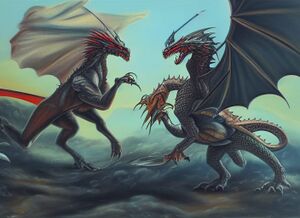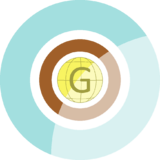Jrakons
This article is a work in progress. Any information here may not be final as changes are often made to make way for improvements or expansion of lore-wise information about Gentu. Please comment on this article's talk page to share your input, comments and questions. Note: To contribute to this article, contact User:Philimania. |
| Jrakon | |
|---|---|

| |
| 17th century painting of three Jrakons fighting each other. | |
| Scientific classification | |
| Kingdom: | |
| Phylum: | |
| Class: | |
| Order: | |
| Family: | Jrakonia
|
| Major groups | |
Jrakons, also known as dragons are a diverse group of reptiles of the order Fokisauria and first appeared during the Late Aevum Reptilium 72 to 62 million years ago, although the origins of jrakons are still a topic of active debate and research. They became the dominant terrestrial reptile on Gentu after the Reptilium-Pagan extinction event wiped out the Dinosaurs 62 million years ago. Jrakon dominance continued through most of the Pagan Era before ending during the middle of the Neoceyn Period 2.5 mya which coincided with the development of stone-tools among the human species. This eventually led to the decline of the jrakon population in Naphtora and later the rest of Gentu during the Great Migration. At the start of the Prehistorical Era, there is believed to have been around 7,000 species of jrakons in Naphtora and Oranland alone. By the end of the Great Migration 10,000 years ago, there were only 600 species left.
Jrakons are represented on almost all continents by both extant species and fossil remains. Reseearch on jrakons have shown that some were herbivorous while other were carnivorous. Additionally, jrakon saliva proves to be quite flammable, allowing them a tool to fend against other creatures and kill prey. Evidence also suggests that all jrakons are egg-laying, and that nest-building was a trait shared by many jrakons, both avian and non-avian.
Although most modern jrakons are ancestrally avian and bipedal, extinct jrakon groups are shown to included quadrupedal species, and some were able to shift between these stances. Extravagant displays such as horns and crests are common in both modern and ancient jrakons. While the largest modern jrakons can only reach a length of roughly 15 m (50 ft) from head to tail and a height of 5 m (16 ft), the largest extinct jrakon can reach a length of about 100 m (330 ft) and a height of 30 m (100 ft).
Definition
Etymology
The term 'jrakon' derives from the word δράκων in Pylosan which can be Alarcianised into 'drákon' which translates to 'serpent' in Pylosan. Overtime, the term 'drákon' was corrupted into 'jrakon' in Veragese which was later borrowed into the Neragese lexicon sometime during the Middle Era.
General description
TBA
Distinguishing anatomical features
TBA
History of the study of Jrakons
TBA
Evolutionary history
TBA
Classification
TBA
Taxonomy
TBA
Timeline of major groups
TBA
Biology
TBA
Size
TBA
Behaviour
TBA
Communication
TBA
Reproduction
TBA
Physiology
TBA
Extinction
TBA
Human depiction
TBA

